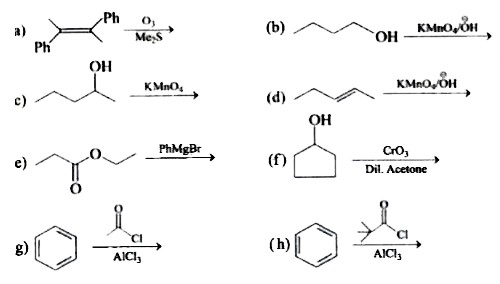Describe the synthetic reactions of alkyl halides, illustrating how a wide variety of organic compounds can be synthesised from them?
To describe the synthetic reactions of alkyl halides and illustrate how a wide variety of organic compounds can be synthesized from them, we can follow these steps:
Step 1: Formation of Grignard Reagents
Alkyl halides can react with magnesium to form Grignard reagents, which are organometallic compounds. For example, ethyl bromide (C2H5Br) reacts with magnesium in dry ether to form ethyl magnesium bromide (C2H5MgBr).
Reaction:
C2H5Br+Mgdry ether−−−−−→C2H5MgBr
Step 2: Formation of Organolithium Compounds
Similarly, alkyl halides can react with lithium to form organolithium compounds. For instance, ethyl bromide can react with lithium to yield ethyl lithium (C2H5Li).
Reaction:
C2H5Br+Lidry ether−−−−−→C2H5Li+LiBr
Step 3: Synthesis of Tetraethyl Lead
Alkyl halides can also be used to synthesize tetraethyl lead (TEL) by reacting with sodium lead alloy. Ethyl bromide reacts with sodium lead alloy to form TEL.
Reaction:
4C2H5Br+Na-Pb alloy→C2H5(PbEt)4+4NaBr+Pb
Step 4: Formation of Alcohols
Grignard reagents can react with water or dilute acid to form alcohols. For example, ethyl magnesium bromide can react with water to yield ethanol.
Reaction:
C2H5MgBr+H2O→C2H5OH+Mg(OH)Br
Step 5: Formation of Ethers
Alkyl halides can also react with alcohols to form ethers through a nucleophilic substitution reaction. For example, ethyl bromide can react with methanol to form ethyl methyl ether.
Reaction:
C2H5Br+CH3OH→C2H5OCH3+HBr
Conclusion
In summary, alkyl halides serve as versatile intermediates in organic synthesis. They can be transformed into a variety of compounds including organometallic compounds (Grignard and organolithium reagents), alcohols, ethers, and tetraethyl lead, showcasing their importance in organic chemistry.
---
Alkyl halides can react with magnesium to form Grignard reagents, which are organometallic compounds. For example, ethyl bromide (C2H5Br) reacts with magnesium in dry ether to form ethyl magnesium bromide (C2H5MgBr).
C2H5Br+Mgdry ether−−−−−→C2H5MgBr
Similarly, alkyl halides can react with lithium to form organolithium compounds. For instance, ethyl bromide can react with lithium to yield ethyl lithium (C2H5Li).
C2H5Br+Lidry ether−−−−−→C2H5Li+LiBr
Alkyl halides can also be used to synthesize tetraethyl lead (TEL) by reacting with sodium lead alloy. Ethyl bromide reacts with sodium lead alloy to form TEL.
4C2H5Br+Na-Pb alloy→C2H5(PbEt)4+4NaBr+Pb
Grignard reagents can react with water or dilute acid to form alcohols. For example, ethyl magnesium bromide can react with water to yield ethanol.
C2H5MgBr+H2O→C2H5OH+Mg(OH)Br
Alkyl halides can also react with alcohols to form ethers through a nucleophilic substitution reaction. For example, ethyl bromide can react with methanol to form ethyl methyl ether.
C2H5Br+CH3OH→C2H5OCH3+HBr
In summary, alkyl halides serve as versatile intermediates in organic synthesis. They can be transformed into a variety of compounds including organometallic compounds (Grignard and organolithium reagents), alcohols, ethers, and tetraethyl lead, showcasing their importance in organic chemistry.
Topper's Solved these Questions
- HALOALKANES AND HALOARENES BOOK - ICSECHAPTER - HALOALKANES AND HALOARENES EXERCISE - ISC EXAMINATION QUESTIONS
4 Videos
- HALOALKANES AND HALOARENES BOOK - ICSECHAPTER - HALOALKANES AND HALOARENES EXERCISE - MULTIPLE CHOICE QUESTIONS
29 Videos
- HALOALKANES AND HALOARENES BOOK - ICSECHAPTER - HALOALKANES AND HALOARENES EXERCISE - EXERCISE (PART - II DESCRIPTIVE QUESTIONS) (SHORT ANSWER QUESTIONS)
94 Videos
- GENERAL PRINCIPLES AND PROCESSES OF ISOLATION OF ELEMENTS BOOK - ICSECHAPTER - GENERAL PRINCIPLES AND PROCESSES OF ISOLATION OF ELEMENTS EXERCISE - EXERCISE (PART-I ( OBJECTIVE QUESTIONS )) (Fill in the blanks)
60 Videos
- ISC QUESTION PAPERBOOK - ICSECHAPTER - ISC QUESTION PAPEREXERCISE - PART-II(SECTION-B)
74 Videos
Similar Questions
Knowledge Check
Grignard reagent, a very useful starting compound for a number of organic reactions can be prepared by
Areaction of alkyl halides with a solution of magnesium hydroxideBreaction of alkyl halides with a solution of magnesium powder in presence of dry etherCreaction of MgCl2 with ether and alcoholDreaction of alkyl halide with magnesium in presence of alcohol.In the given pairs of alkyl-halide, in which pair the first compound is more reactive than second compound toward SN2 reaction ?
A(CH3)2CHBr or CH3−CH2−CH2−BrBCH_(3)-CH_(2)-CH_(2)-Br" or "CH_(3)-CH_(2)-CH_(2)-CH_(2)-1CPh−Br or CH3−CH2−CH2−BrDCH2=CH−CH2−Cl or H2C=CH−Cl
When alkyl halides reaction with aromatic compounds in presence of anhydrous AlCl3 , the reaction is known as
View SolutionHow are interhalogen compounds formed? What general compositions can be assigned to them?
View SolutionConsider the following reactions and identify how many reactions can give carnobyl compounds as major product.

View SolutionWhich of the following compound can not obtained from wurtz reaction.
View SolutionIn the following questions, a statement of assertion (A) is following by a statement of reason (R )
A : when alkyl halide is reacted with AgCN then alkyl isocyanide is formed .
R : AgCN is a covalent compound and only the site of nitrogen is available for the reaction.
View SolutionRead the given passage and answer the questions number 1 to 5 that follow:
The substitution reaction of alkyl halide mainly occurs by SN1 and SN2 mechanism. Whatever mechanism alkyl halides follow for the substitution reaction to occur, the polarity of the carbon halogen bond is responsible for these substitution reactions. The rate of SN1 reactions are governed by the stability of carbocation whereas for SN2 reactions steric factor is the deciding factor. If the starting material is a chiral compound, we may end up with an inverted product or racemic mixture depending upon the type of mechanism followed by alkyl halide. Cleavage of ethers with HI also governed by steric factor and stability of carbocation, which indicates that in organic chemistry, these two major factors help us in deciding the kind of product formed
1. Predict the stereochemistry of the product formed if an optically active alkyl halide undergoes substitution reaction by SN1 mechanism.
2. Name the instrument used for measuring the angle by which the plane polarised light is rotated.
3. Predict the major product formed when 2-Bromopentane reacts with alcoholic KOH.
4. Give one use of CHI3
5. Write the structures of the products formed when anisole is treated with HI.
View Solution
